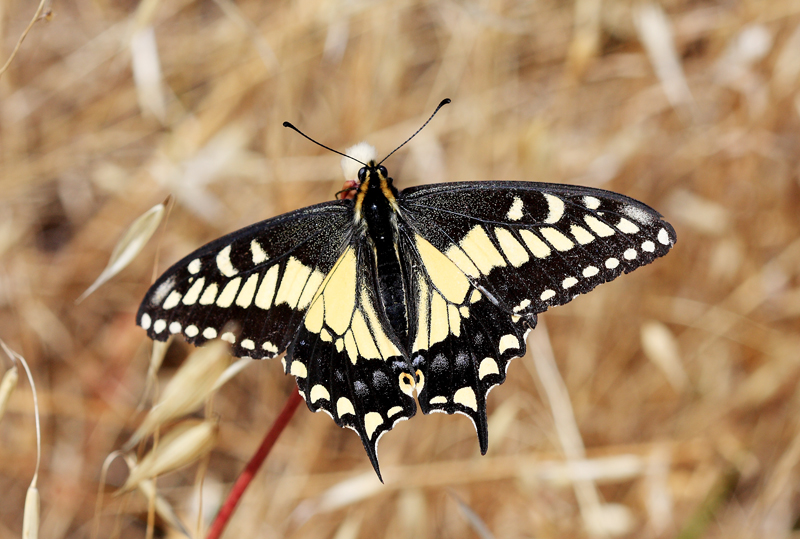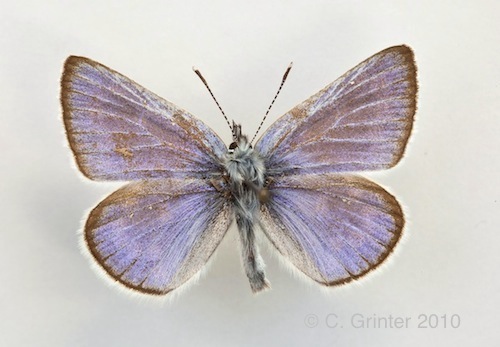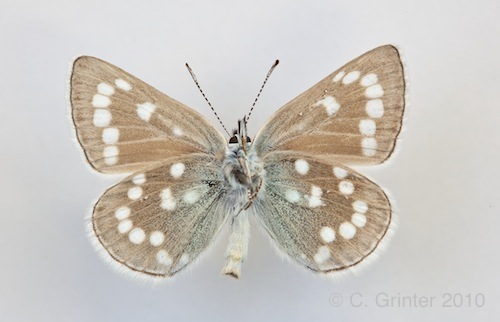Вось мужчына, які ўзвышаецца на ўзгорку Матылёк ад целиакии, або Аніс ластаўка. Гэтая матылёк шырока распаўсюджана ў заходняй частцы Ціхага акіяна і, верагодна, сустракаецца значна часцей, чым раней. Пасля ўвядзення фенхеля (Foeniculum vulgare), і наступны ўцёкі з садаводства, анісавая ластаўка прыжылася як звычайны каліфарнійскі матылёк. Магчыма, раней гэты завод абагнаў нашы абочыны zelicaon магчыма, былі абмежаваныя перадгор'ямі Сьеры, цяпер вы можаце знайсці яго ў садах па ўсёй Каліфорніі. Хаця, На поўдні Каліфорніі ўсё памяншаецца, дзе гэты матылёк знікае з гарадскіх раёнаў. Нядаўняе занясенне цыганскай молі ў раёны Вентуры / Лос-Анджэлеса паклала пачатак рэжымам апырсквання інсектыцыдамі – не кажучы ўжо пра з'яўленне інвазійных паразітычных Tachinidae, якія любяць больш буйныя лепсы. На ўсходнім узбярэжжы гэтая паразітычная муха і моцнае распыленне знішчылі імперскую моль (Eacles Imperialis) з большай часткі яго дыяпазону, пакідаючы яго пад пагрозай знікнення на большай частцы Новай Англіі.
For those who don’t know, hill-topping behavior is a butterfly “king of the mountain” of sorts. A number of butterfly species (among other insects and possibly some moths) will regularly patrol the highest peaks in mate seeking behavior. Some authors consider this as lekking behavior, аднак “anthro”pomorphizing butterflies with other animal behavior is easy to do. Males seem to compete for the best position on the highest peak, of which females frequent the most. Back in my home state of Illinois “peaks” or even hills are far and few in-between. Instead, butterflies use railroad paths or even houses.
I photographed this butterfly in spring in San Francisco during the 16th annual SF Butterfly count. After 5 hours of hiking McLaren Park my group tallied a staggering twelve species. Across all of San Francisco proper the count was a record breaking 24! Добра, not that impressive and probably staggeringly depressing when you consider how many species we know that were lost…let alone what were aren’t even aware of. As a fond memory, here is a Xerces blue (Glaucopsyche lygdamus xerces) that is held here in the collections of the California Academy of Sciences. The label reads “Сакавік 20 1932, Сан-Францыска”.
2010 SF Butterfly count
Papilio rutulus – Western Tiger
Papilio zelicaon – Anise Swallowtail
Battus philenor – Pipevine swallowtail
Pieris рапа – Cabbage white
Euchloe ausonides – Large Marble
Colias eurytheme – Orange Sulphur
Strymon melinus – Gray Hairstreak
Celastrina echo – Echo Blue
Plebejus acmon – Acmon Blue
Agraulis vanillae – Gulf Fritillary
Phyciodes pulchella – Field Crescent
Phyciodes mylitta – Mylitta Crescent
Euphydryas chalcedona – Variable Checkerspot
Nymphalis californica – California Tortoiseshell
Ванэса virginiensis – American Painted Lady
Vanessa cardui – Painted Lady
Vanessa annabella – West Coast Lady
Ванэса Аталанта – Чырвоны адмірал
Junonia coenia – Buckeye
Coenonympha tullia california – California Common Ringlet
Pygrus communis – Common Checkered Skipper
Hylephilia phyleus – Fiery Skipper
Polites sabuleti – Sandhill Skipper
Poanes melane – Umber Skipper
Total: 24 віды, 775 individuals




Glad to see the butteryfly count is still going. And it’s posts like this one that sends me back in time.
As a kid and native San Franciscan, my friends and I did many day hikes around places like Ft. Funsten, Pine Lake, and Lake Merced, or along Brotherhood Way and behind Lowell High School before these areas were fully developed. But even during the 70’s, I remember the number of butterfly species was not many. The Anise Swallowtail was fairly common, even then.
The Xerces Blue was already long gone but, as kids, we did wonder if it were possible a small population lingered on, somehow overlooked and unnoticed…мы не знайшлі яго 🙁
Would be curious to see what species were recently counted and compare with what I can remember. Will have to check it out over at the NABA website. Ўра!
Just updated with a list – meant to do that right away!
I spent last summer in Santa Barbara backcountry with a distant hope of finding the extinct unsilvered fritillary (atossa). I bet you can guess how that ended.
Thanks for updating. Noted that NABA only offers listings for a fee. Considering these are compiled by volunteer efforts, not sure I agree. Так ці інакш, I note the absence of the Mourning Cloak, Nymphalis antiopa (which I presume is still around). And now the presence of the Gulf Fritallary. Інакш, ды, a very familiar list.
[…] blues – if the invasive species can be controlled – it won’t go the way of the Xerces. Пераехала самка – Twin Peaks […]
[…] Photo by Chris Grinter (http://skepticalmoth.southernfriedscience.com/2010/08/butterfly-porn/) […]